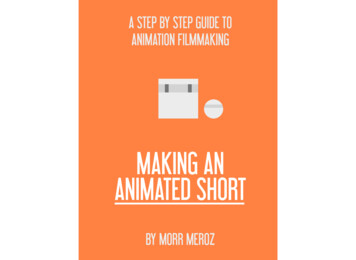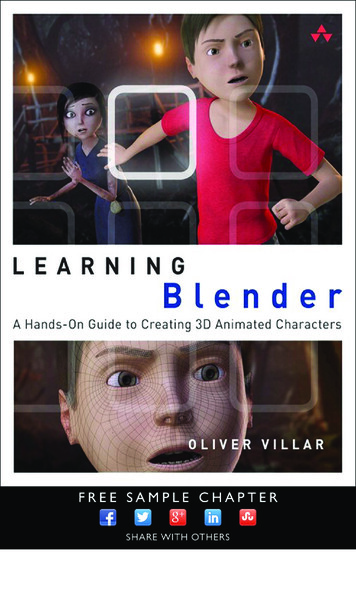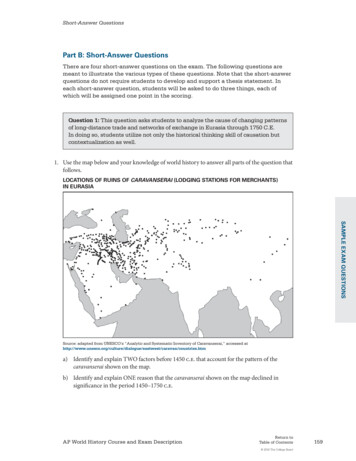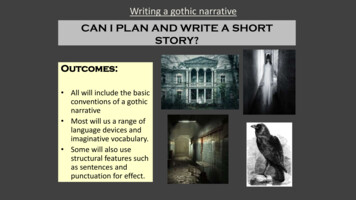
Transcription
A STEP BY STEP GUIDE TOANIMATION FILMMAKINGMAKING ANANIMATED SHORTBY MORR MEROZ
COPYRIGHTS 2014 Morr MerozAll rights reserved. No part of this publication may be reproduced, distributed, or transmitted inany form or by any means, including photocopying, recording, or other electronic or mechanicalmethods, without the prior written permission of the publisher, except in the case of briefquotations embodied in critical reviews and certain other noncommercial uses permitted bycopyright law. For permission requests, write to the publisher, addressed “Attention:Permissions Coordinator,” at the address mFirst Edition.i
DISCLAIMERThe author and publisher of this Ebook and the accompanying materials have used their bestefforts in preparing this Ebook. The author and publisher make no representation or warrantieswith respect to the accuracy, applicability, fitness, or completeness of the contents of thisEbook. The information contained in this Ebook is strictly for educational purposes. Therefore, ifyou wish to apply ideas contained in this Ebook, you are taking full responsibility for youractions.ii
INTRODUCTION Who is This Book For? A Word From the Author My Story
WHO IS THIS BOOK FOR?This book is for everyone who ever dreamed of makingtheir own animated movie.You may be a high school student trying to make ananimated video for YouTube, or a college student looking fornew direction. You might be a working animator who justcouldn't find the time to make that short and need a little push.This book is for those who are curious about what it takes tomake an animated short. If you’re reading this you probablyalready think animation is pretty cool, but I know the actualreality of making a film could look a bit vague andoverwhelming.In this guide I will remove the curtain and tell you everything Iknow about animation filmmaking. I’ll go over all the types ofmaking an animated short, from finding the right idea toexporting the final film.If you are an experienced animator working in the industryyou’ll probably already know most of the stuff covered in thisiv
book, but I’m sure that there could be something newto learn here for everyone. Feel free to skip sectionsthat you already know a lot about.For people who are looking for a more in depth lookinto getting into the animation industry, I recommendchecking out or flagship ebook Animation ForBeginners. It covers all the different types of animationand basic animation principles. It comes witha complete hardware and software guide (for 2D, 3Dand stop motion), must-have books as well asa detailed list of the best animation schools with alltheir information.It also has plenty of practical guides such ascreating an effective demo reel, building your ownportfolio website, and even how to get a job in theanimation industry.Check out the book s-bookv
A WORD FROM THE AUTHORHey, first of all I want to thank you for downloadingthis ebook.I wrote this guide so that I could share everything I’ve learned(and still learning) about making animation. I’m not some expertor an animation guru but I do work as a character animator andmake animated shorts.I love what I do, and I also love sharing what I know withothers in hope of inspiring or at least teaching something new.Everything I talk about is presented with complete transparency,so that you get a backstage look to how things are done.I wrote the guide I would have wanted to have years agowhen I was making my first film for college. I’ve tried includingeverything a newbie might want to know.I know many people want to make awesome things but don’talways know where to start (or how). To some people theprocess of making a film looks daunting. I hope that sharing thisbook with you will push you to get started, or at least show youhow.vi
Affiliate disclaimer:This ebook contains some affiliate links, which means I receive a smallcommission on a purchase without additional cost to you. I do believe in allproducts mentioned in the book and have experience with them.If you do purchase through my affiliate links, thank you so much for yoursupport!vii
MY STORYI’m Morr, a NYC based animator/filmmaker.After graduating from the School of Visual Arts (majoring in3D animation), I started my career as a character animator,freelancing in various studios.Despite loving what I do, I felt like it’s not enough to work forother people, and that I HAVE to keep doing my own thing.What started as a YouTube tutorial channel has quickly evolvedinto the Bloop Animation blog, a platform on which I can sharemy work with a great audience of animators and creative artists.On the site, I documented my journey of making LIFT UP (mysecond animated short) and shared many video tutorials aboutevery step of the making process.I truly hope that sharing my journey will inspire people tofollow their passion. Thank you again for downloading thisguide, hope you like it.-Morrviii
MAKING AN ANIMATED SHORT Making Your First Film How to Make an Animated Movie
Section 1MAKING YOUR FIRST FILMWhy Make a Film?Making a short film is a necessary step for every filmmaker. It’s aright of passage one must take to learn the ins and outs ofproduction. It’s no different for animators. If you went to college foranimation, chances are you graduated with a short film (often calleda thesis film). This is crucial because it’s one of the only chancesyou’ll have to get really dirty with hands-on production experience.If you’re thinking of getting into animation, or maybe you’re tryingto do it on the side without taking a 4 year degree program, then youshould seriously consider making a short film on your own.The film doesn’t have to be loaded with production value. Not atall. All you need to do is think about what you are trying to get out ofthe film. In your case, I’m guessing you’re interested in animation(otherwise you probably wouldn’t have gotten this far in the book),10
but even if you’re more into modeling or rigging orwhatever it is, just think about the goal of this first film.The goal is to get your skills presented in the bestway.What do I mean by that?Well, say you don’t want to be an animator, thenI didn’t stop there. I also wanted the animation tonot be too challenging so that I could push it as far as Icould without spending an extreme amount of time.That’s why I chose fish, They don’t have legs orfingers. They’re basically a floating head (which I spenttime making sure is full of expressive expressions).It might sound like I was lazy, but that wasn’t it. Imaybe a film about 5 characters heavily interactingknew how hard it is to animate, so I tried giving myselfwith each other isn’t the best idea for you.the best chance of making great animation withoutWhen I made my student film Food For Thought Iknew I wanted to give my animation skills as muchtaking more than I could handle. I didn’t forget I wasonly a beginner.room as possible so that I wouldn't waste productionOthers had films with 2-3 human characters andtime on stuff I’ll never do again (such as modeling andwinded up with mediocre animation. That’s becausetexturing), so I kept them as basic as I could.animating full bodied people is really really hard, and itMy film had two characters, and one location. Thatway I could concentrate on the interaction betweentakes a long time.The bottom line of what I’m trying to say is that youthem and not worry about environment modeling,should only take projects you know you can handle,lighting, texturing and all that stuff.and more importantly, that you know you can finish.11
Starting a project without finishing is worst than notstarting at all, and it’s a huge waste of time.Why Make a Second FilmThis part is for those who already finished their firstshort. You must feel good about yourself, and youshould. Making a film is a huge accomplishment.Ok, now that it’s done - are you ready for anotherone?Here’s a fact:Every person that graduated from animation/filmschool has a short film.Here’s another fact:The Second FilmThe film/animation industry is intense.When you get booked on a job or a project thehours are very long and the work is demanding. Thatcould make it very hard to ever have time to work onyour personal project. I know that many recentgraduates have said that they would like to makeanother film, but so few of them ever do.Hey, I get it Making a film is really hard. In school it takes usbetween 1-2 years to finish a film.But here’s the thing – it’s only going to get harder.The more you wait before making your second film theharder it’s going to be to do it.Very few people have ever made another one.You’re going to have a lot of stuff going on. A job,spouse, kids After school is probably the mostrelaxed time you’ll ever have until you’re 50. Plus, youstill have that momentum going from finishing your first12
film. That’s why making your second film right after theeasy being one of those people. If you’re like that andfirst is probably the best time to do it.you get some job and just stop making things you’reBut why make another one anyway?You already got your awesome demo reel right? It’sfull of great shots from your film, and you don’t reallyneed another one. Plus, your first one won all thesespecial awards and went to all these festivals, so whydo you really need to do that all over again when youcan probably get a job right now?Well There’s basically two good reasons to do it:1. You want to keep creating.2. You’re having trouble getting work.CreatingThis is for those who enjoy the creating process.Born filmmakers. Pixar fans. People who for themgoing to be very unhappy very quickly.Those people have to work on some kind of projectin their spare time. Evenings, weekends It’s a must.Even if it takes you 3 years instead of 1, try keepingthat creative work alive – for your sake. It’ll be worth it.Trouble getting workThat’s another problem that might arise. You havethat awesome demo reel with all these film awards –but guess what? So does everybody else. And forsome reason they did a better job networking than youand you’re stuck for weeks (or even months) without afreelance project.In that case having a second film puts you in such ahuge advantage over the rest, because it not onlyshows your talent, but also your dedication,management skills, accountability and so forth.creating is not a choice. And let me tell you, it’s not13
Plus it gives you something to do when you’re athome waiting for that email to ring.Sad isn’t it?The Biggest ChallengeWhat’s really hard about keeping at it is the fact thatafter sitting all day in front of a computer moving pixelsSome people say “the last thing I want to see when Iget home is Maya.”Well, you need to push through that if you want tostand out of the crowd.My pointI’m using a second film as an example for somethingaround at your freelance gig, you get home at 7-8PMbigger. The idea of staying creatively active afterand. sit on your computer moving pixels around.graduation. You’re a creative person right? OtherwiseThat’s hard.you wouldn’t be reading this book right now. Don’t letthe daily routine kill your creativity. Remember whoyou were before you got that job.14
Section 2HOW TO MAKE AN ANIMATED MOVIEI hope I convinced you that making a film is important, but if you’rejust starting out you probably have no idea how to even begintackling such a project.You might ask yourself - what do I need? What’s the priority of thedifferent tasks? How much time should I spend animating before Imove on to lighting? How long should it be? How do I know if thisidea is good and worth pursuing?I can’t answer every question completely, since every project isdifferent, but I can break down the different steps it takes to make ananimated short, and help you focus on the right questions and tasks.This section will be all about the steps of making ananimated movie.15
Coming Up with an Idea.Like I said in the previous section - your idea shouldbe focused on the skill you’re trying to show off. Itnature proves the exact opposite. People wantboundaries! They love them.A quick example: If I told you to draw a tree, youshould be very small and executable. I cannot stressmight feel a bit ‘ugh’ or even freeze for a second. Thenthis enough - if this is your first film - don’t overdo it!you’d probably scribble some generic tree and moveDon’t take more than you can handle because you’llon, not being creative or feeling inspired.either not finish the film or get a mediocre one. Bothresults are useless and a waste of time.So how DO you come up with the right idea for you?If, however, I told you to draw a tree using onlytriangles, an artist would get excited. She would startthinking about how to do it, start thinking aboutStart by restricting yourself to what you can’t do. I callcreative solutions and try to make something uniqueit the Restriction Method.and interesting. I bet it wouldn't look generic at all andWhat is The Restriction Method? Don’t worry, it’snot some flaky theory, but a logical system I came upI bet every tree would look different.That’s what creativity is - finding interestingwith that will get you to a solid idea, even if you feelsolutions to problems. A blank canvas has nostuck.problems, that’s why it’s so hard to face it.The Restriction Method is pretty much what isNow that I explained what the Restriction Method is,sounds like. It’s all about making restrictions forlet’s examine the real life example of how I used it foryourself to induce creativity and ideas. You might thinkmy own film - LIFT UP.that artists want ‘freedom’ and ‘space’, but human16
Since I knew I would be doing this animated shortfilm all by myself, I had to have restrictions. So Idecided to write them down. The movie will have only two main characters. It will take place in 1 location It needs to be humorous. It will be under a minute.I already had a stronger starting point than mostpeople just by writing down those rules for myself, butI took it a step further. Since I am not so good with 3Dmodeling, I decided to restrict myself even more.I decided that my two main characters would be aball and a cube. No eyes, no legs and no arms. Notonly would that make my 3D modeling and riggingprocess a lot easier but it would also be an amazingchallenge as an animator, bringing life into such basicshapes. Two birds in one stone! In fact, one of themost common comments I got from people whowatched the film was “I can’t believe how muchemotion you got out of a freaking cube!”So now that I have all the rules set up it’s time tocome up with the actual story. I started thinking andbroke down the elements in order to build the story:What’s the main difference between a ball and acube? Well, one of them is round and the other is flat.When will those differences make a difference? Thefirst thing that came to me was walking. If you don’thave any legs or arms it will be a lot easier to movearound as a ball rather than a cube. So I already havea conflict between the characters: A cube who isslowly trying to walk down a path and an arrogant ballzooming around it, showing off, while the cube isstruggling.That’s a great start. I have established a conflictbetween the two characters and found an interestingdynamic. But then I needed to find the twist. Not ashocking twist but something that changes things17
around. I asked myself: In what case would a cubethe story from your brain into written words. This ishave the advantage over a ball? The answer was clear:especially important if you have dialogue in the film.A slope. In a downhill slope the ball would roll quicklybut going up the hill would be hard.So now I have a cube and a ball walking down aMy first film Food For Thought had plenty ofdialogue and I spend a lot of time with the scriptbefore moving on to drawings. However, on mylong road, and while the cube is struggling to movesecond film LIFT UP, I skipped the script and wentforward, the ball is rolling around freely, mocking her.straight to storyboarding. That was because that storyWhen they reach a hill, the cube climbs easily (since itwas more physical than verbal. I felt like drawing ithas flat sides) but the ball cannot get enoughinstead of writing it would be easier, and it’s just asmomentum to follow.effective in learning new things about the story.Will the cube help the ball after its display ofI use Celtx for script writing. It’s a great writingarrogance and selfishness? That was for me to decide,software that syncs on multiple devices. It’s verybut look at that: I had a story. I would never havefriendly to use and fun to write with. Another greatthought about that had I not restricted myself in thesolution is Final Draft, which seems to be very popularprocess.with screenwriters. For more information onWriting the ScriptThe next step after coming up with ideas is putting itdown on paper. You discover a lot when you translatescreenwriting format go here.StoryboardingAfter you come up with an idea and put it to writing,it’s time for storyboarding. For you, animators and18
artists, this should be one of the most fun steps,despite looking daunting at first.The storyboard’s biggest role is to convey the storyeffectively, as close as possible to what the movie willlook like at the end. That means that when someone isreading your storyboard they should instantly get thestory.So what is a storyboard? A storyboard is a series ofdrawings meant for pre-visualizing the shots of amovie. It is an essential tool for the director (in thiscase - you) so they could get a sense of the way themovie is going to look and feel.A storyboard is also used in live action productionsand saves time on set. Since the camera angles wereA few things to help convey the story: Write captions under the drawing Use arrows to show camera movements Color the object to differentiate it from thebackground. My preferred template for storyboarding is sixdetermined beforehand, the DP (director ofboards on a single page (each one 16 9 – HD ratio),photography) knows exactly what is expected of himthree on top of three, with a few empty lines forduring the shoot.writing captions under each one.There are different approaches to storyboarding.You can download a storyboard template I made forSome like to use colors, some only draw the outlines,you and the full storyboard I made for LIFT UP here forsome color in greyscale (my preferred method) andreference.some go really deep into the details.19
AnimaticAfter the storyboard is done you’ll need to turn itinto an animatic.Simply put, an animatic is an animated storyboard.Boards are brought together in an editing program andare edited with the correct timing and pace of the film.They include basic sound effects and dialoguerecordings.Similar to storyboards, animatics are used for previsualizing the film before production starts. Animaticsare extremely important for making an animatedmovie, since they let you see what the movie mightlook like for the first time. This is when you first get asense of the pacing, the rhythm and the progression ofthe film.This is also the last step before going into 3D, so it’simportant to make sure no more story changes needto be made.Adobe After Effects is the most common softwarefor creating animatics.With After Effects you can: Manipulate the drawings with the puppet tool (ifnecessary). Easily add elements to the view screen (such asframe count, time-codes and shot number). Export in various codecs and formats.ModelingAfter we have our story figured out and the animaticlooks good, we step into the 3D world for the firsttime. We usually start with modeling the characters,props and environments.Modeling in 3D is the process of building andshaping a character or an object in a 3D software, tomatch the design. The modeling is done based on thecharacter design and is something I have less20
experience with. That’s the reason I chose to go with acube and a ball when I made LIFT UP, since they arethe easiest objects to work with. I worked within myrestrictions.For a deeper learning of modeling techniques IRiggingRigging is the process of taking a 3D model andbuilding a skeleton into it so it could move the way wewant it to. This is a very important step for animatorsbecause they are the ones who will later have to moverecommend checking out Mastering Autodesk Mayathat skeleton. You need to know in advance what kind2014 or Digital Modeling. If you’re more into videos I’dof movement or facial expression you want therecommend taking some Digital Tutors online courses.character to make. That’s why many animators have atleast a basic understanding of rigging and aresometimes just as good at it as they are atanimating.To learn more about rigging check outMastering Autodesk Maya 2014 or any of therigging courses at Digital Tutors.Previsualization (Previz)After you have all the 3D assets made (they arerigged and ready to go) you’ll first make a previzof your entire film.21
Previsualization (previz) is the process of making astripped down version of your film before actuallyThere’s no one formula for the way a previzlooks, but I’ll share with you the way I do it.making it. Made within the 3D program, a previz isanimated very basically, just enough to get the storyacross. Think of it like a 3D animatic.It’s a good idea to leave space around your actualfilm for displaying various information. I usually justscale down the video and add a black background inIn recent years, live action filmmakers have startedmy editing program (I use Adobe After Effects). Aroundmaking previsualizations before shooting their films,the video there are a few elements I like to havebecause it’s such a great way to see how shots lookshown:before actually going out and shooting them. It couldsave a lot of time and money if you know the scene is The film title on the top middle.going to work ahead of shooting. WIP (Work in Progress) on the top left, so thatFor animation, just like live action, it’s a necessarystep. Animating takes so much time that you wouldn’twant to waste days and days working on a shot onlyto find out later that the sequence doesn’t work. Afterstoryboarding and making an animatic, previz is thelast step before diving into full animation.viewers will know this is still in development. Timecode on the bottom middle – one of the mostimportant elements. Frame count on the bottom right – timecode isn’tenough, sometimes you need to know the exactframe count of shots, or when giving comments it’seasier to specify what frames need changing.22
Shot number on the bottom left – so you caninstantly know what shot you’re watching whenwriting notes or comments. Focal length (or lens size) above the shot numbers– not a must have, but I like to know the kind of lens Iused for each shot.Camera Shots and AnglesSpeaking of cameras, here are a few things youshould know about setting up your shots, cameralenses and movement.Great cinematography is always challenging toachieve. Great and convincing cinematography in 3DAt the end you should have a version of your filmcan be even more complicated. Why is it challenging?with basic animation. The camera movement shouldBecause in a 3D environment (the 3D software) therebe finalized, because you’re going to keep it for theare no limitations, unlike real life where you areanimation phase.restricted by the rules of physics or by the budget ofyour film.Creating a flying helicopter camera shot and asimple tripod shot costs the same in 3D, and thatcould be a problem.When first learning the capabilities of the 3Dsoftware, many newbies tend to go crazy with thecamera. Either using an extravagant boom shot whereit isn’t needed, or creating shots that would beimpossible to achieve in real life.23
But hey! – you might say – isn’t that whata big crane shot, you’ll get that natural arc in theanimation is for?movement of the camera that is caused by the boombeing a physical rod.Well, yeah, if you have a good reason for it – surego crazy. But going crazy just because you can isn’tthe right way to go about it. You must remember thatthe audience is used to watching movies in a certainway. Knowing basic rules of cinematography andunderstanding the uses of different lenses is critical tomaking a good animated film.If you’re using Maya, here are 2 camera rigs that Iuse: Maya Camera rig (from creativecrash.com)The reason I think this rig is excellent, despite Maya cameraThis is the default Maya camera that anyone cancreate. The advantage of using this simple rig is thathaving many buttons and controls, is that it simulatesyou can look through the camera lens and movea real dolly/boom rig.around, just like in the perspective view. This is greatThis is important because when you are animatingmildly complex shots it’s important to have somethingthat grounds you in reality. With this rig, if you’re doingfor when you’re just trying to figure out your shot anddecide on a good direction for your camera angle andlens.24
Speaking of lenses, let’s talk about them for asecond. In Maya we determine the lens in the ‘FocalLength’ attribute. If you’re familiar with lenses then youshould be able to figure out the right sizes for yourneeds, but if you need a little guidance, here is aquick reference: 8-15 focal length: Used for very wide shots,landscape, establishing shots, creating deepperspective. 35-55 focal length: Used for close ups, mediumshots, whenever you just want to show a characterdoing something without being too intrusive. 80 – 200 focal length: Used to flatten out theperspective, extreme close ups or for quick actionshots.Voice ActingIf your film has any dialogue you’ll probably needvoice actors. When I made Food For Thought I wasfacing a very dialogue heavy film and the search for avoice actor was not something I had experience with.Luckily, I was introduced to Voices.com, a greatwebsite for finding voice actors. It’s really great,because you can submit a sample dialogue and getdozens of auditions from actors reading your scriptwithin 24 hours. Hearing my script come to life wasone of the most exciting moments in the production.AnimationThis is what it’s all about right? This book is aboutgetting into animation. Of course, I’m not going tocover the entire art of animation in this section, but Ican tell you what’s it like animating, and the skillsrequired.First of all, it’s important to know that you’ll mostlikely be focusing on very short segments of animationat a time.What do I mean by that?25
A film is broken down into sequences. EachThe camera movement and angle should already besequence is made out of a few scenes and everyin place from the previz, and the character rigs shouldscene is made out of shots. A shot is defined as abe in the right places. Before jumping into animating,take, in part or in its entirety, that is used in the finalhowever, some preparation is needed.edited version of the film. It’s the piece of the filmbetween two edits, a "piece of time.” In live action filma shot is everything between the moment you startHere are a few things you can do: Shoot reference. Even though you think you mightrecording to the moment you stop the camera. Then inknow what an action looks like, you’ll be surprisedthe editing process the editor cuts these shots to thehow much you don’t think about until you watch thetimeframe they need.action and analyze it. It’s good practice to recordIn animation we only animate those final timeframesfor the final edit. In a film they might shoot the samescene from 3 different angles, where in animation weonly animate the time needed for each angle. It’s muchless flexible but since animation is such a timeconsuming task studios just can’t afford to have allangles animated.A shot is usually very short, so in reality an animatorwouldn’t animate a shot that’s more than a fewseconds at a time.yourself on video doing that action even if you’re notgoing to animate it exactly the same. It’s good tohave that reference nearby. You can also YouTube itinstead of shooting it yourself. Say you need toanimate a skydiver, it’s probably easier to look onlinefor a reference video than shoot one yourself. Thumbnail the shot. If you have good drawingskills, it might be good to thumbnail the main posesof your shot and then refer to them while youanimate. I admit it’s something I do not do since I like26
diving straight into the animation, but it’s something IFor example, if the character is furry you’ll need toknow many good animators do, so keep that in mind.find a way to create fur material to add to it. The sameAfter the preparation we start by blocking out theshot. Then, we refine it until it’s done.For more detailed information about the process ofanimation read the ‘6 Steps of Animation’ section.Texturing Lighting and RenderingOnce animation is finished and you’re happy withgoes for reflective materials like glass.After setting up all the materials and the lights in theshot we determine the render settings (resolution,quality and many others depending on the type ofrender engine). Now all that’s left is the actualrendering.Studios would usually use a render farm, which is athe way the movie feels, it’s time to handle the way itnetwork of many computers connected together forlooks. The process of texturing, lighting and renderingthe sole purpose of rendering. That results in fasteryour film is very technical, but basically it’s taking eachrender time. If the scene isn’t too complex you canshot of the film and establishing the lights andrender it on your own computer (I rendered LIFT UP byappropriate 3D materials to the characters andmyself on my 2010 iMac).environment before rendering the final output.27
The topic of texturing, lighting and rendering islook different despite happening in the same location,extremely complex and deep. If you intend to le
checking out or flagship ebook Animation For Beginners. It covers all the different types of animation and basic animation principles. It comes with a complete hardware and software guide (for 2D, 3D and stop motion), must-have books as well as a detailed list of the best animation schools with all their information.File Size: 2MBExplore furtherFree Animated Cinema 4D Models - Download c4d Files .www.turbosquid.comFree 3D Cartoon Animation Maker - Create Animated Video .animiz.comHow to Create 3D Animation Video Online for Freewww.techjockey.comOnline Animation Maker Make Animation for Free .www.renderforest.comintroduction to 2D-animation working practicebooksite.elsevier.comRecommended to you b










